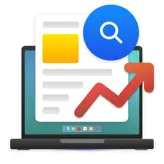
How to Rank Product Pages in Google's New Product SERPs
Published April 7, 2025
Angie Perperidou shares 7 strategies to optimize for product SERPs in 2025. Ecommerce SEOs, have a read!
Google is taking over the search experience with features like product carousels, AI overviews, and interactive grids. Instead of leading users to traditional category pages, Google now provides product details (images, prices, and reviews) directly in search results.
This shift means that your product pages are no longer just competing with other websites but with Google itself. If your pages aren't optimized with structured data, unique content, and eye-catching visuals, they might not even show up in these new SERPs.
In this article, we’re going to look at how Google’s product SERPs have changed over time, and how you can optimize for these new SERP features.
Contents:
- Evolution of the SERP
- What’s new in Google’s product SERPs
- 7 Strategies to optimize for the new product SERPs
- Recommended tools for optimization
- Key takeaways
Evolution of the SERP
Below is a timeline of how Google has evolved its search features to dominate user queries:

Let's explore what these changes mean for SEO and how you can adapt to stay ahead.
What’s New in Google’s Product SERPs?
Google’s new product SERPs prioritize product information over category-level content. Users now see interactive grids featuring product images, descriptions, pricing, and reviews directly from the search results. These SERPs usually rely on product data pulled from structured data on websites.
For example, here’s how the SERPs for “puppy accessories” appear:


Google also displays product carousels in AI Overviews. This shift means product pages must be SEO optimized AND structured correctly for Google to understand and display them.
As Aleyda Solis says: “Please double down on your product detail pages optimization!”
Here you can see an example of product carousels in AI Overviews:

Why does this matter? If your product pages are missing key details, they may not appear in these SERPs at all, which means lost traffic and sales. So how do you make your product pages rank in this new landscape? Check out these 7 winning strategies.
7 Strategies to Optimize for the New Product SERPs
1. Use Schema
Schema markup helps search engines understand the content on your pages. Adding Product, Offer, and AggregateRating schema can increase your chances of appearing in product grids and carousels.
Action Guide:
Ensure that you implement the necessary product-related schema types on all product pages. Regularly audit your schema to spot and fix any errors.
Example of a Sitebulb Structured Data report for a puppy accessories eshop:

Learn to audit structured data with Sitebulb
Here are written instructions on how to audit structured data using Sitebulb and here is a video tutorial on auditing structured data in Sitebulb.
2. Focus on Long-Tail Queries
Long-tail keywords are more specific and often less competitive than short search terms. Targeting these queries lets you capture niche search traffic and improve your product page relevance.
Examples:
- Soft chew toy for teething puppies
- Waterproof winter jacket for small breed puppies
- Adjustable no-pull harness for growing puppies
Action Guide:
Identify long-tail keyword opportunities using keyword research tools. Regularly audit your rankings. This means checking which of your product pages are ranking for long-tail keywords (e.g., "soft chew toy for teething puppies"). If a page isn't ranking, it may need better optimization (improved product description, more relevant keywords, or additional structured data).
By analyzing rankings and making adjustments, you ensure your pages remain visible and relevant in Google’s evolving product SERPs.
3. Craft Unique, Detailed Product Descriptions
Avoid copying manufacturer descriptions. Write original, detailed content that highlights the unique features and benefits of the product. As Google mentions, providing "original information" helps improve rankings and keeps users engaged. This improves your chances of ranking and keeps users engaged.
Action Guide:
Regularly audit your product descriptions for uniqueness. Reverse engineer the top SERPs and optimize according to the products that are ranking.
Example:
To rank for “best puppy chew toy for teething”
- Analyze the top-ranking pages using SEO tools.
- Check their titles, descriptions, content structure, schema markup, and user engagement signals.
- Identify patterns: do they have unique descriptions, reviews, FAQs, or comparison tables?
- Optimize your page by writing original content, adding UGC, using structured data, and improving visuals.
- Track rankings and adjust based on performance.
4. Use FAQs on Product Pages
FAQs help address common customer concerns and can include additional keywords. Well-structured FAQs also increase engagement and time spent on the page.
Action Guide:
Add relevant FAQ sections to the product pages and use FAQ schema to help them appear in rich results. Regularly review and update FAQs to match evolving customer queries.
Example:
You can use the following tools to find content ideas for the FAQs, on “best puppy chew toy for teething”:
- AlsoAsked.com
Users ask, "What is the safest chew toy for teething puppies?" Add this to your FAQ.
- Reddit & Quora
Dog owners discuss "Soft vs. firm chew toys what's better?" Address this in your FAQ content.
- Google Search Console
Look for queries like 'Best puppy teething toy for aggressive chewers' to identify specific needs. Include in your FAQs details on durability, safety, and suitability for aggressive chewers.
- Customer Support Data
Customers often ask, "Is this toy safe for small breeds?". Clarify sizing details in your FAQs.
5. Optimize for Video and Image Carousels
High-quality product images and videos can help the product pages get featured in Google’s image and video carousels. Ensure that the images are properly optimized with descriptive alt text.
Action Guide:
Use descriptive filenames and alt text for all images. Compress files to improve load times without sacrificing quality. My favorite tool for this is TinyPNG because it is simple, effective, and fast. Plus, who can resist a helpful little panda?

6. Use UGC (User-Generated Content)
UGC, like reviews and ratings, increases trust and engagement. Google often displays ratings in product SERPs, making them more eye-catching and increasing click-through rates.
Check out the below example with review ratings in the SERPs (marked in red).

Action Guide:
Encourage customers to leave reviews and make sure you implement Review schema on your website. Using structured data ensures reviews are recognized by search engines.
7. Mobile Optimization
Since most product searches happen on mobile, your pages must load quickly and provide a smooth user experience on all devices.
Action Guide:
Test your product pages for mobile performance. Address issues like slow load times and poor layouts to ensure a seamless user experience.
Sitebulb will automatically flag mobile optimization issues when you audit your site.
Recommended Tools for Optimization
To implement and monitor these strategies effectively, consider using the following tools:
- Sitebulb: For identifying technical SEO issues, auditing structured data, duplicate content, and mobile performance.
- Ahrefs: For keyword research and tracking performance in SERPs.
- Google Search Console: To monitor search visibility and address indexing issues.
Using a mix of these tools can help you stay on top of Google’s ever-changing requirements.
Key Takeaways
Google’s product SERPs continue to evolve, making product pages more critical than ever for e-commerce SEO. By focusing on structured data, high-quality content, user engagement, and mobile performance, you can ensure your product pages stay competitive.
Using SEO tools like Sitebulb can help you monitor and improve key areas, making it easier to adapt to these changes. Stay proactive, keep improving your product pages, and you’ll be better positioned to rank well in Google’s ever-changing search results.
You might also like:

Sitebulb is a proud partner of Women in Tech SEO! This author is part of the WTS community. Discover all our Women in Tech SEO articles.

Angie is an SEO and PPC specialist at WayMore.io. Her mission is to help marketers succeed on Google, LinkedIn, and Meta. She shares practical tips to improve rankings, drive traffic, and boost conversions. When not optimizing, she keeps marketers updated on Google changes, SEO tools, AI tools, Ready-made templates, and Online courses. Follow her on LinkedIn to stay ahead in SEO, PPC, and digital marketing.
Articles for every stage in your SEO journey. Jump on board.
Related Articles
 SEO for Growth Case Study: Revolutionizing a Saturated Market
SEO for Growth Case Study: Revolutionizing a Saturated Market
 PDP Optimization: A Blueprint for Product Pages People Love & Buy From
PDP Optimization: A Blueprint for Product Pages People Love & Buy From
 5 Revolutionary Strategies for Enterprise Ecommerce SEO
5 Revolutionary Strategies for Enterprise Ecommerce SEO
 Sitebulb Desktop
Sitebulb Desktop
Find, fix and communicate technical issues with easy visuals, in-depth insights, & prioritized recommendations across 300+ SEO issues.
- Ideal for SEO professionals, consultants & marketing agencies.
Try our fully featured 14 day trial. No credit card required.
Try Sitebulb for free Sitebulb Cloud
Sitebulb Cloud
Get all the capability of Sitebulb Desktop, accessible via your web browser. Crawl at scale without project, crawl credit, or machine limits.
- Perfect for collaboration, remote teams & extreme scale.
If you’re using another cloud crawler, you will definitely save money with Sitebulb.
Explore Sitebulb Cloud Angie Perperidou
Angie Perperidou

